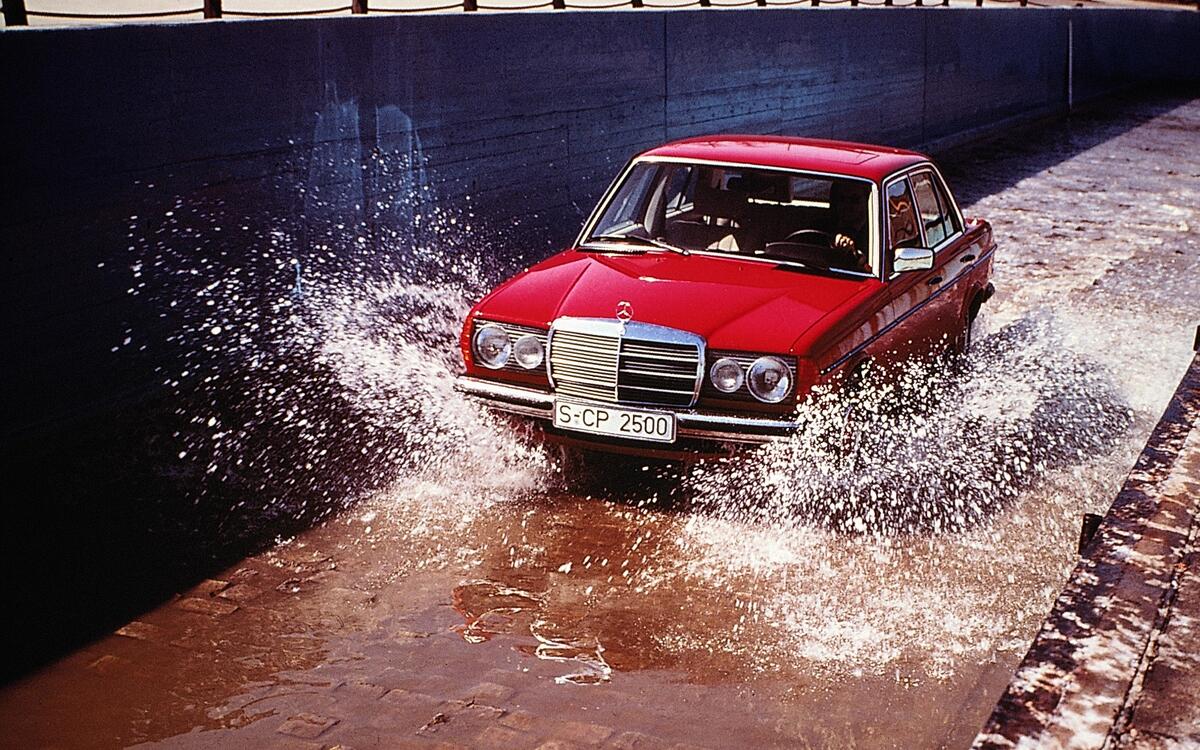The following versions and sub-models of Mercedes-Benz W123 Sedan phase-I were available in 1976: 1976 Mercedes-Benz 200 (low compr.) (man. 4) specs Mercedes-Benz 200 (low compr.) (man.
- 230, 240D,TD, 300D,TD. 1976 thru 1981: D Style D switch layout Burl Walnut grain diesel & gas models: E Style E Factory black plastic Used only: Note: Large hazard switch: Includes new rubber shift boot and new mounting peg.
- W123 is the internal chassis-designation Mercedes-Benz used for their executive line of cars, manufactured between 1976 and 1985. The W123 models surpassed their predecessor, the W114 and W115 models, as the most successful Mercedes, selling 6.7 million cars before replacement by the W124 after 1985.
The overall dimensions and wheelbase were lengthened and styling was updated to a less angular more contemporary look. The new look included round head lights with inboard fog lamps in all models except the 280 and 280E which had large rectangular headlights. Later the European models were all changed to the rectangular headlights. North American models retained the round complement.
The W115 engines were carried over to the new models, with the 3 liter 5-cylinder diesel model being renamed from '240D 3.0' to '300D' in the European markets to match North American markets ( in the North American markets the 240 designated the 2.4L 4 cylinder version).
The 250 models were given a new 2525 cc inline-six (Type M123, a short-stroke version of the 2.8 liter six Type M110) this replaced the 2496 cc Type M114 six.
In the spring of 1976, a coupe version of the W123 was introduced on a shorter wheelbase than the saloon (2,710 mm (106.7 in) versus 2,795 mm (110.0 in)). This W123C/CE was available as a 230C (later 230CE) and as a 280C/CE in most markets; in North America there was also a 300CD version.
The new models proved to be the most popular series to date. Demand for the W123 was so great, back orders and waiting lists of over a year were common and used cars sold at a premium over the new car list price.
A long wheel base chassis (3,425 mm (134.8 in)) was introduced in August, 1977. The long chassis versions were available as 7/8 seat saloons through the factory and as a bare chassis with front body clip for ambulances, hearse bodies etc. Outside manufactures such as Binz or Miesen produced a variety of models on these long chassis. The long (Lang) versions could be ordered as 240D, 300D and 250 models.
The W123T estate (wagon) was introduced at the Frankfurt Auto Show in September, 1977. Production of the T models (Transport and Touring) began in March, 1978 in the Bremen factory in Germany.
In early 1979, the diesel models power output was increased from 55 PS (40 kW; 54 hp) to 60 PS (44 kW; 59 hp) in the 200D, from 65 PS (48 kW; 64 hp) to 72 PS (53 kW; 71 hp) in the 240D and from 80 PS (59 kW; 79 hp) to 88 PS (65 kW; 87 hp) in the 300D.
Production of the 220D ended in early 1979.
The turbo charged 5 cylinder engine was introduced in September 1979 in the 300TD Turbo diesel wagon. The turbocharged 5-cylinder 3 liter diesel engine (Type OM617) was offered with automatic transmission only and limited to the 300TD in most markets. The North American markets were given Turbo models in the 4-door and coupe models as well, possibly as a response to the competition from higher powered American cars.
In June of 1980 a new 2 liter 4-cylinder gasoline engine (Type M102) was introduced to replace the M115. A fuel-injected 2.3 liter version was introduced to replace the carbureted engine in the 230E/TE/CE models. In 1980/81 the carbureted 280 was replaced with the fuel-injected 280E.
In September 1982 the rectangular headlights from the 280/280E and power steering were standardized across all European models. In February all European models except the 300TD were offered with an optional 5-speed manual transmission.
Production or the W123 ended in January 1986.
Mercedes Benz W123 Diesel

Mercedes W123 Wagon
W123 introduced many innovations in both safety and styling including ABS brakes (optional from August, 1980), retractable steering columns and airbags for the driver (optional from 1982).
Mercedes W123 Diesel

Mercedes Benz W123
Options: MB-Tex (Mercedes-Benz Texturized Punctured Vinyl) upholstery or velour (European market only) or leather upholstery, interior wood trim, passenger side exterior mirror (standard on T models), 5-speed manual transmission (European market only), 4-speed automatic transmission (standard in turbo diesel models), power windows with rear-seat switch cut-outs, vacuum powered central door locking, rear-facing extra seats (station wagon only), Standheizung (prestart timer controlled engine heating), self locking differential, sun roof, air conditioning, climate control, 'Alpine' horn (selectable quieter horn), headlamp wipers (European market only), Tempomat (cruise control), power steering (standard after 1982/08), seat heating, catalytic converter (available from 1984 for California only, from fall (autumn) 1984 also in Germany for the 230E of which one thousand were built).
Power (vacuum servo) assisted disc brakes were standard on all W123s.
